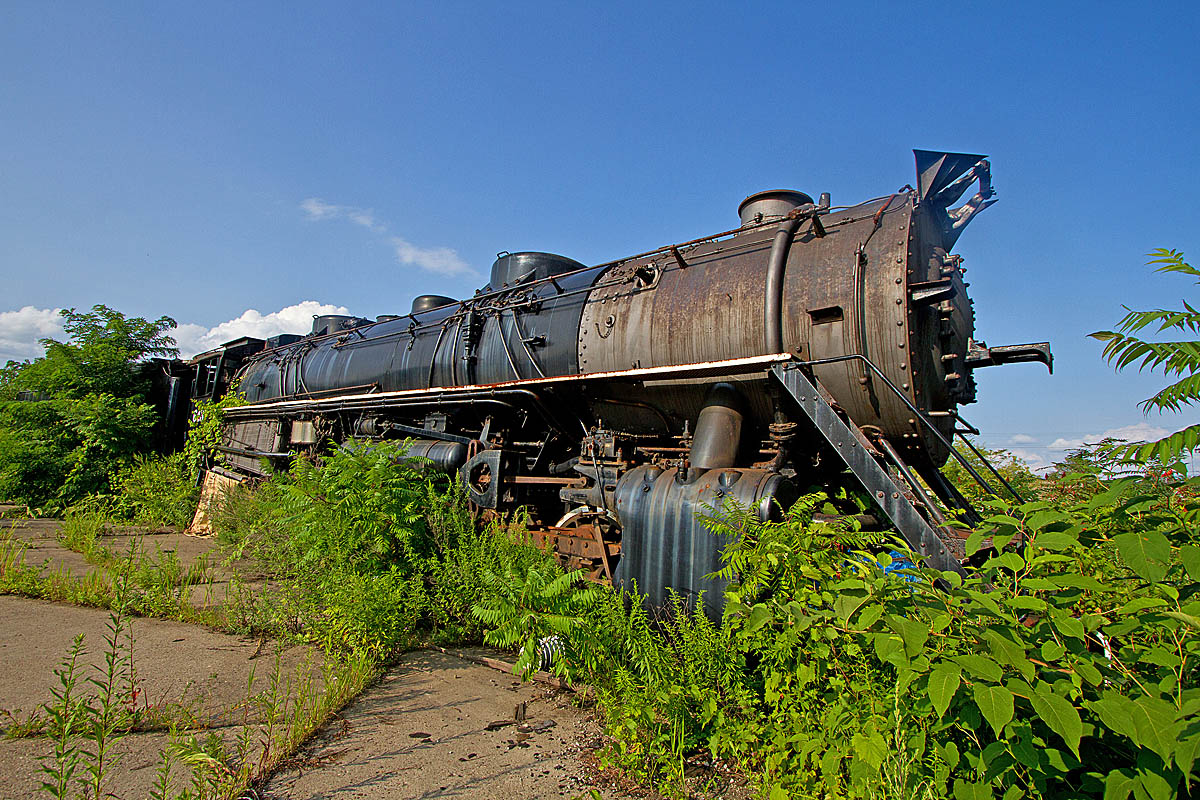Tarentum Borough Manager Bill Rossey tells the Tribune-Review that the engine has been offered to the borough at no cost as a tourist attraction. “There is an antique steam engine sitting in McKees Rocks that we are trying to get up here and put it on display,” he says. “Its been restored, and we want to keep it nice. It’s privately owned and the guys who own it approached me.” The prospective donors wish to remain anonymous. “In talking to them, it sounds to me like they have about $1 million in this engine. They don’t have any other place to put it,” he adds.
Rossey says the pavilion would be along Fifth Avenue. He says there are no firm figures, but he estimates the pavilion will cost about $250,000.
Baldwin built No. 643 in 1943. After steam was phased out on the Bessemer, the engine was retained and stored in the roundhouse in Greenville. It is the last remaining B&LE 2-10-4 from a fleet of 47. The engine remained stored by the railroad until 1983, when it was sold to Pittsburgh rail enthusiast Glen Campbell. Campbell restored and test fired the engine in the late 1980s, but it never pulled any excursions. It has been stored outdoors at the AGF Warehouse in an industrial area of McKees Rocks for several years.
If the engine is moved, it will have to be trucked out of its current location, since the track it rests on is no longer connected to the rail network.















If they need a place to run it the dsrx in maine would run it with mec 470
Lawrence–i"ve wondered the same thing about 614 & 2102. Apparantly, the answer is lack of money and lack of a host railroad willing to let them to run on their rails. The management of many railroads these days is made up of lawyers, not operations personnel. Liability caused by a derailment (or worse, a boiler explosion) overshadows any perceived good will generated by steam operation.
If it has been restored why isn't it running somewhere? Spend the money to restore it to running condition and then just park it borders on the edge of stupidity, to my way of thinking. Why restore a steam locomotive to operating condition if you don't have the track to operate it on? Now some city is going to park at a park? As a tourist attraction? That city should rethink that idea before they spend a lot of money. I like old train locomotives and will stop along the road to view parked locomotives, but I'm not going to plan to spend time just going to a particular city just to view a locomotive in a park.
So glad to hear this. A covered home in a town that appreciates it.
This great machine deserves better treatment. Hopefully, she'll get it.
Wonderful news..
I wonder if it was offered to the rail museum in Greenville?
Now don't go pickin' on lawyers now, Mr. Cole! Remember, Graham and Bob Claytor were lawyers.
We saw it in Greenville in the late 1970s and we've often wondered what became of the engines there. Thankfully it will receive some restoration and not be cut up.
Looks like it was stored inside until the building was taken down between 2008 & 2010.
It sure beats leaving where it is to rust to nothing, or worse, having it scrapped. 'We' all can want them to do more, but 'we' are not paying the bills.
These were lookalikes for CB&Q 6300 series 2-10-4s. Hope it can be made presentable again.
I remember seeing this in a 1988 or 1989 Trains (Paducah & Louisville issue) and the locomotive was shown in good shape and under steam. And now this?
For a railroad to allow a steam operation over their rails, the proponent has to be perceived as highly professional from the very first approach. Knowledge and understanding of current railroading procedures and limitations is absolutely essential for discussions with a possible host. The locomotive and train has to be already proven 99.999% reliable and compliant with all regulations. The locomotive operator will also have to assume all liability in case of an accident, and that requires a large and expensive insurance policy.
For a host railroad, a special operation like this is a nuisance, requiring management involvement far in excess of any financial return. They also have to provide a pilot crew for the engine and train personnel and an operating slot on the subdivision. Both can be problematic in a capacity strained corridor. When one is allowed, it is mostly for the potential good will from the public.
The above issues are most critical when dealing with a Class 1. Short lines often show greater flexibility but are frequently not well suited for operation of big locomotives like this 2-10-4.
It's generally the operations personnel who don't want to host the steam engine, the lawyers just nodding their heads in the background.